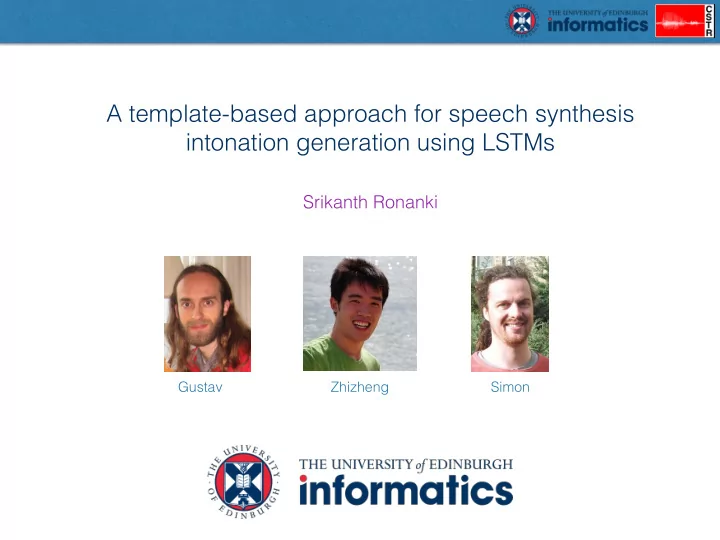

A template-based approach for speech synthesis intonation generation using LSTMs Srikanth Ronanki Gustav Zhizheng Simon
Introduction: Statistical speech synthesis SPSS: Generation based approaches • Vocoder MGC BAP Regression Text Front-end Pitch Model LF0 Speech Waveform generator
Why template-based approach? Lack of convincing intonation makes current parametric systems • sound dull and lifeless. Typically, these systems predict F0 frame-by-frame using regression • models. This approach leads to overly-smooth pitch contours and fail to • construct an appropriate prosodic structure. Templates retain the dynamic range of F0 within the segment. • We propose a classification-based approach to automatic F0 • generation.
Pitch contour
Pitch contour segmentation
Hierarchical clustering Pitch contours
How to determine number of clusters?
A set of templates (clusters)
Intonation reconstruction from templates Goldilocks and the three bears /g@Ulwd/ /lI/ /Qks/ /pau/ /and/ /D@/ /Tri/ /bE@z/ 2 4 5 4 4 4 2 5 Mean pitch 2 4 5 4 4 4 2 5 Duration
Intonation reconstruction
Hierarchical clustering - Recap Training Data force-aligned durations • Interpolate the F0 contour of each utterance and segment into syllables segmentation (syllable) • Apply DCT based decomposition: duration c0 representing the mean over syllable, normalisation c = [c1,…,CN-1], representing the shape of the contour Pitch patterns (DCT features) • Perform top-to-bottom hierarchical clustering mean normalisation over the patterns ( c ). Clustering (Hierarchical)
Proposed approaches Pitch Syllable contour 70 52.5 35 Neural Network classifiers: 17.5 0 1 2 3 4 5 6 A hierarchical deep neural network classifier (HC). • template counts in the data ‣ The first DNN choses between flat and non-flat template. ‣ The second DNN choses among rest of the non-flat templates. A simplified LSTM with a CTC output layer (CTC). • ‣ Connectionist temporal classification coupled with S-LSTM to predict the sequence of templates given sequence of phonemes.
Waveform smoothing Vocoder MGC BAP F 0 Acoustic features Output layer o t i t C t Acoustic S-LSTM 1 − f t f t Input Input Input #1 #2 #3 Frame-level F0 Frame-level linguistic features F0 reconstruction d ( t ) Phone durations Syllable templates CTC output layer Intonation S-LSTM Duration S-LSTM Phone-level linguistic features Input Input Input #1 #2 #3 Linguistic features Text analysis Text
Results: systems Baseline system • ‣ MSE - A frame-wise regression baseline predicting F0 using LSTMs. Proposed systems • ‣ HC - A hierarchical deep neural network classifier ‣ CTC - A simplified LSTM coupled with CTC output layer ‣ Oracle - A oracle system using templates derived from natural F0 contour but with predicted F0 mean and duration
Objective evaluation Classification measures • ‣ Accuracy - percentage of templates correctly classified ‣ F1 score - is a measure of test’s accuracy (precision and recall) Model Accuracy F1 score HC 61.1% 0.590 CTC 63.8% 0.593
Objective evaluation F0 prediction measures • ‣ RMSE - Root mean square error ‣ CORR - Pearson correlation 47 0.6 45.25 0.45 43.5 0.3 0.15 41.75 0 40 MSE HC CTC Oracle MSE HC CTC Oracle Fig: Correlation of predicted F0 Fig: RMSE of predicted F0 • Oracle templates + Oracle F0 mean - 0.89 (corr.)
Subjective evaluation Reference systems • ‣ MSE - A frame-wise regression baseline predicting F0 using LSTMs. ‣ BOT - A bottom line using piecewise-constant F0 per syllable (the mean natural F0) ‣ BMK - A benchmark system using force-aligned durations and natural F0 contours ‣ VOC - A top line of vocoded speech (STRAIGHT in this work)
Subjective evaluation: MUSHRA 7 Subjective rank (highest is best) 6 5 20 listeners • 20 out of 32 test • 4 stimuli 3 2 1 VOC BOT BMK MSE HC CTC Oracle Fig: Box plot of aggregate ranks from listening test. Red lines are medians, orange squares means.
Summary and conclusions A classification approach to intonation prediction with syllable F0 • templates Proposed approach matches the performance of conventional • approach Has potential to exceed it once the issues with oracle template • system are overcome Future work: • ‣ Better smoothing techniques and word-level templates ‣ Use the prediction probabilities as features for frame-level regression approaches
Code Code for templates and clustering • ‣ https://github.com/ronanki/Hybrid_prosody_model Code for training neural networks • ‣ https://github.com/CSTR-Edinburgh/merlin
Recommend
More recommend